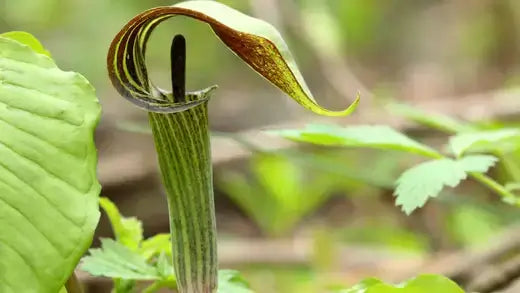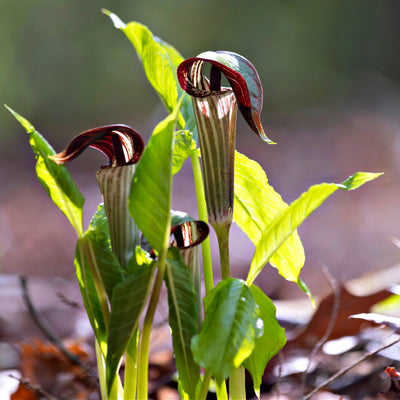Gardens are fascinating spaces that offer many experiences for those who tend to them or stroll through their paths. Within these verdant realms, a myriad of plant species coexist, each with its own story to tell and unique contributions to make.
Among these botanical residents, the Jack-in-the-Pulpit is an enigmatic and captivating presence. With its distinctive appearance and a history rich in symbolism and cultural significance, this plant brings a touch of mystery and intrigue to any garden. In this exploration, we delve into the world of the Jack-in-the-Pulpit, uncovering its characteristics, benefits, and the deep connections it forges with nature and human culture.
Unveiling the Jack-in-the-Pulpit

The Jack-in-the-Pulpit, scientifically known as Arisaema triphyllum, is a perennial herbaceous plant native to eastern North America. Its most striking feature is the unique flower structure that is like a preacher in a pulpit, hence its common name. This structure consists of a hood-like leaf called the spathe that envelops and shelters a stalk-like system called the spadix. The tiny flowers are clustered on the spadix, making it appear like a "Jack" is standing within the "pulpit." The spathe of the Jack-in-the-Pulpit comes in an array of colors, including green, purple, and brown, and its size can vary significantly. The plant typically grows in moist woodland areas, where its distinctive appearance makes it an eye-catching inhabitant.
Botanical and Cultural Significance Cultural and Symbolic Importance:
The Jack-in-the-Pulpit has deep-rooted symbolism in various cultures. Among Native American tribes, the plant held spiritual significance, often symbolizing protection and fertility. Its phallic-shaped spadix and sheltering spathe were seen as representations of male and female energies, giving rise to associations with fertility rituals and beliefs. In Christian contexts, the plant's resemblance to a preacher in a pulpit has led to interpretations of humility and the importance of spiritual guidance.
Medicinal Uses:
While the Jack-in-the-Pulpit has cultural and symbolic importance, it also possesses medicinal properties. Some Native American groups used its roots to create poultices for treating minor wounds, skin irritations, and insect bites. However, it's important to note that parts of the plant include calcium oxalate crystals, which can irritate if ingested, making its medicinal use complex and potentially hazardous without proper preparation.
Benefits in the Garden Biodiversity and Habitat Support: When introduced to a garden, the Jack-in-the-Pulpit contributes to biodiversity by providing habitat and food sources for various insects, particularly pollinators. The plant's distinct flower structure and scent attract insects, aiding in cross-pollination and contributing to the reproductive success of neighboring plants.
Natural Aesthetic Appeal: The unusual form of the Jack-in-the-Pulpit adds an element of intrigue to garden landscapes. Its architectural shape and vibrant spathe colors create a striking focal point. When strategically placed amidst other flora, the plant can enhance the garden's visual appeal and overall ambiance.
Educational Opportunities: Including Jack-in-the-Pulpit in a garden setting offers educational value. It allows garden enthusiasts, students, and nature lovers to learn about unique plant adaptations, reproductive strategies, and cultural history. This educational aspect enriches the gardening experience and fosters a more profound connection to the natural world.
Cultivation and Care Cultivating
Jack-in-the-Pulpit in a garden requires understanding its habitat preferences and growth conditions. The following guidelines can contribute to successful cultivation:
- Shade and Moisture: The plant thrives in moist, shady environments that mimic its woodland origins. Partial to full shade provides the ideal conditions for its growth. Ensuring consistent moisture in the soil is crucial, as the plant is adapted to a habitat with high humidity levels.
- Soil Composition: Well-draining, humus-rich soil with a slightly acidic to neutral pH range is recommended. Amending the soil with organic matter can enhance moisture retention and create a fertile environment for growth.
- Propagation and Maintenance: Jack-in-the-Pulpit can be propagated through seeds or division. Seeds should be sown as soon as they mature in the fall, as they have a limited shelf life. Dividing established clumps during the dormant season can also yield new plants. Regular mulching and watering are essential for maintaining the desired moisture levels.
Ethical Harvesting and Conservation Due to its cultural significance and potential medicinal uses, ethical considerations must be taken into account when interacting with the Jack-in-the-Pulpit: Responsible Harvesting: If considering Jack-in-the-Pulpit for cultural or educational purposes, it's essential to harvest responsibly. Only take small amounts, leaving the majority of the plant population intact. This practice ensures the plant's continued survival and its role in supporting local ecosystems.
Conservation Awareness: The wild populations of Jack-in-the-Pulpit are vulnerable to habitat loss and overharvesting. Engaging in conservation efforts, such as supporting local native plant nurseries or participating in habitat restoration projects, can contribute to preserving this unique species.
Conclusion
In the enchanting realm of gardens, the Jack-in-the-Pulpit stands as a botanical marvel that bridges the gap between cultural significance, ecological benefits, and aesthetic allure. Its captivating form and historical symbolism make it a plant of intrigue, drawing individuals into a deeper appreciation for the natural world and its interconnectedness with human culture. As we cultivate and care for this enigmatic presence in our gardens, we develop a sense of wonder and respect for the intricate tapestry of life that surrounds us.

